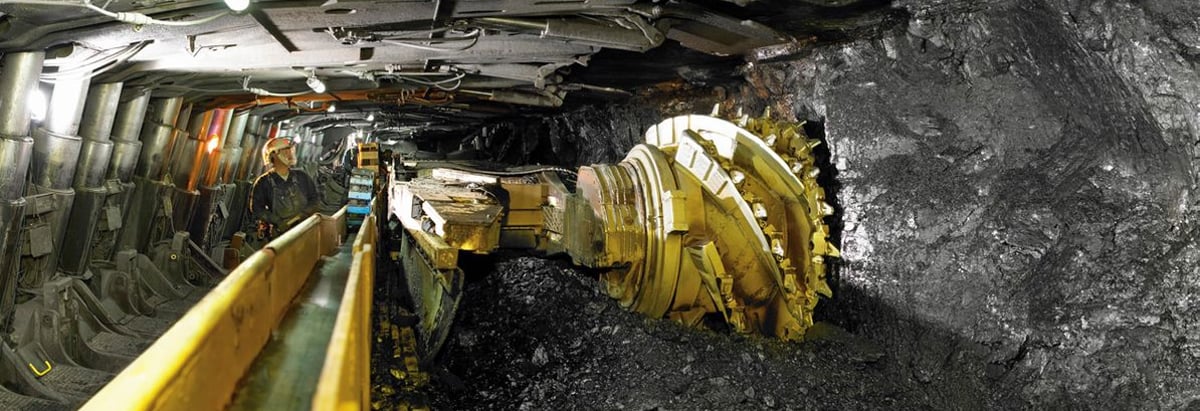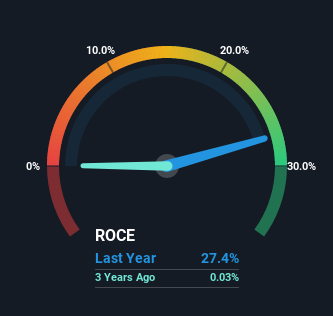- United States
- /
- Oil and Gas
- /
- NYSE:BTU
Peabody Energy (NYSE:BTU) Knows How To Allocate Capital Effectively

If we want to find a potential multi-bagger, often there are underlying trends that can provide clues. Amongst other things, we'll want to see two things; firstly, a growing return on capital employed (ROCE) and secondly, an expansion in the company's amount of capital employed. If you see this, it typically means it's a company with a great business model and plenty of profitable reinvestment opportunities. Speaking of which, we noticed some great changes in Peabody Energy's (NYSE:BTU) returns on capital, so let's have a look.
Understanding Return On Capital Employed (ROCE)
For those that aren't sure what ROCE is, it measures the amount of pre-tax profits a company can generate from the capital employed in its business. The formula for this calculation on Peabody Energy is:
Return on Capital Employed = Earnings Before Interest and Tax (EBIT) ÷ (Total Assets - Current Liabilities)
0.27 = US$1.3b ÷ (US$5.6b - US$919m) (Based on the trailing twelve months to December 2022).
Thus, Peabody Energy has an ROCE of 27%. That's a fantastic return and not only that, it outpaces the average of 21% earned by companies in a similar industry.
Check out our latest analysis for Peabody Energy

Above you can see how the current ROCE for Peabody Energy compares to its prior returns on capital, but there's only so much you can tell from the past. If you'd like, you can check out the forecasts from the analysts covering Peabody Energy here for free.
So How Is Peabody Energy's ROCE Trending?
We're pretty happy with how the ROCE has been trending at Peabody Energy. The figures show that over the last five years, returns on capital have grown by 168%. That's not bad because this tells for every dollar invested (capital employed), the company is increasing the amount earned from that dollar. In regards to capital employed, Peabody Energy appears to been achieving more with less, since the business is using 32% less capital to run its operation. Peabody Energy may be selling some assets so it's worth investigating if the business has plans for future investments to increase returns further still.
The Bottom Line
In the end, Peabody Energy has proven it's capital allocation skills are good with those higher returns from less amount of capital. Given the stock has declined 28% in the last five years, this could be a good investment if the valuation and other metrics are also appealing. So researching this company further and determining whether or not these trends will continue seems justified.
If you'd like to know more about Peabody Energy, we've spotted 3 warning signs, and 1 of them makes us a bit uncomfortable.
High returns are a key ingredient to strong performance, so check out our free list ofstocks earning high returns on equity with solid balance sheets.
New: Manage All Your Stock Portfolios in One Place
We've created the ultimate portfolio companion for stock investors, and it's free.
• Connect an unlimited number of Portfolios and see your total in one currency
• Be alerted to new Warning Signs or Risks via email or mobile
• Track the Fair Value of your stocks
Have feedback on this article? Concerned about the content? Get in touch with us directly. Alternatively, email editorial-team (at) simplywallst.com.
This article by Simply Wall St is general in nature. We provide commentary based on historical data and analyst forecasts only using an unbiased methodology and our articles are not intended to be financial advice. It does not constitute a recommendation to buy or sell any stock, and does not take account of your objectives, or your financial situation. We aim to bring you long-term focused analysis driven by fundamental data. Note that our analysis may not factor in the latest price-sensitive company announcements or qualitative material. Simply Wall St has no position in any stocks mentioned.
About NYSE:BTU
Very undervalued with flawless balance sheet.
Market Insights
Community Narratives




